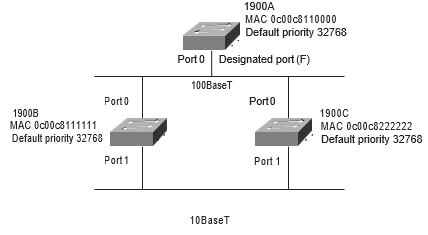CCNA Exercise Lab 2
Answer the following questions based on the following graphic.

1. Which is the root bridge?
Ans – Bridge ID-1900A is the root bridge. A root bridge is a Switch which is located at the top of the network and connecting to other switches.
2. What are the designated ports?
Ans – A designated port is the port on a segment which has the lease cost to reach to the switch. In this design port0 on switch 1900A is the designated port and port 1 on either switch 1900B, 1900C could be a designated port. A switch can have multiple designated ports but has only one ‘root port’.
3. What are the non-designated ports?
Ans – A designated port is called a non-designated port if it has no root port. Non-designated ports have no role to play and are put in blocking state.
4. Which ports are blocking?
Ans – The port-1 on Switch 1900B and 1900C, one of the port is in blocking state or non-designated,
Review Questions
- Which LAN switch method runs a CRC on every frame?
- Cut-through
- Store and forward
- FragmentCheck
- FragmentFree
- Ans- B
- Which LAN switch type only checks the hardware address before forwarding a frame?
- Cut-through
- Store and forward
- FragmentCheck
- FragmentFree
- Ans- A
- What is true regarding the STP blocked state of a port? (Choose all that )
- No frames are transmitted or received on the blocked
- BPDUs are sent and received on the blocked
- BPDUs are still received on the blocked
- Frames are sent or received on the blocked
- Ans- C,D
- Layer-2 switching provides which of the following?
- Hardware-based bridging (MAC)
- Wire-speed
- High latency
- High-cost
- Ans- A, B
- What is used to determine the root bridge in a network? (Choose all that )
- Priority
- Cost of the links attached to the switch
- MAC address
- IP address Ans – Priority & MAC
- Ans- A, C
- What is used to determine the designated port on a bridge?
- Priority
- Cost of the links attached to the switch
- MAC address
- IP address
- Ans- B
- What are the four port states of an STP switch?
- Learning
- Learned
- Listened
- Heard
- Listening
- Forwarding
- Forwarded
- Blocking
- Gathering
- Ans- A, E, F, H ( Blocking, Listening, Learning, Forwarding )
- What are the three distinct functions of layer-2 switching?
- Address learning
- Routing
- Forwarding and filtering
- Creating network loops
- Loop avoidance
- IP addressing
- Ans- A, C, E
- What is true regarding BPDUs?
- They are used to send configuration messages using IP
- They are used to send configuration messages using multicast frames.
- They are used to set the cost of STP
- They are used to set the bridge ID of a
- Ans - B
- If a switch determines that a blocked port should now be the designated port, what state will the port go into?
- Unblocked
- Forwarding
- Listening
- Listened
- Learning
- Learned
- Ans- C
- What is the difference between a bridge and a layer-2 switch? (Choose all that )
- Bridges can only have one spanning-tree instance per
- Switches can have many different spanning-tree instances per switch.
- Bridges can have many spanning-tree instances per
- Switches can only have one spanning-tree instance per
- Ans- A, B
- What is the difference between a bridge and a layer-2 switch? (Choose all that )
- Switches are software
- Bridges are hardware
- Switches are hardware
- Bridges are software
- Ans- C, D
- What does a switch do when a frame is received on an interface and the destination hardware address is unknown or not in the filter table?
- Forwards the switch to the first available link
- Drops the frame
- Floods the network with the frame looking for the device
- Sends back a message to the originating station asking for a name resolution
- Ans- C
- Which LAN switch type waits for the collision window to pass before looking up the destination hardware address in the MAC filter table and forwarding the frame?
- Cut-through
- Store and forward
- Fragment Check
- Fragment Free
- Ans- D
- What is the default LAN switch type on a 1900 switch?
- Cut-through
- Store and forward
- FragmentCheck
- FragmentFree
- Ans- D
- How is the bridge ID of a switch communicated to neighboring switches?
- IP Routing
- STP
- During the four STP states of a switch
- Bridge Protocol Data Units
- Broadcasts during convergence times
- Ans- D ( BPDUs )
- How is the root port on a switch determined?
- The switch determines the highest cost of a link to the root
- The switch determines the lowest cost of a link to the root
- The fastest BPDU transfer rate is determined by sending and receiving BPDUs between switches, and that interface becomes the root
- The root bridge will broadcast the bridge ID, and the receiving bridge will determine what interface this broadcast was received on and make this interface the root
- Ans - B
- How many root bridges are allowed in a network?
- 10
- 1
- One for each switch
- 20
- Ans- B. Only 1 per network
- What could happen on a network if no loop avoidance schemes are put in place?
- Faster convergence times
- Broadcast storms
- Multiple frame copies
- IP routing will cause flapping on a serial link
- Ans- B
- What is the default priority of STP on a switch?
- 32,768
- 3276
- 100
- 10
- 1
- Ans- A


